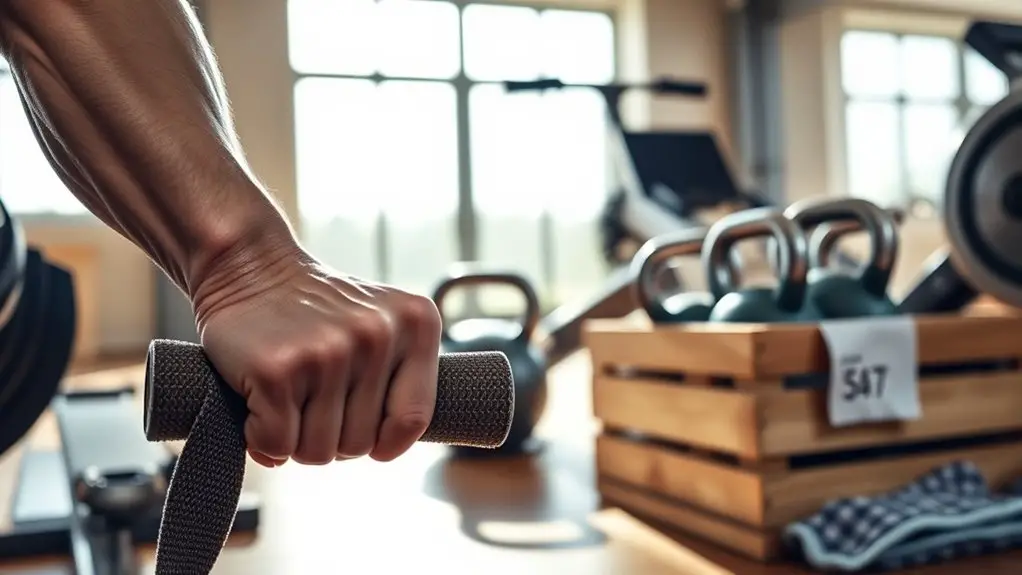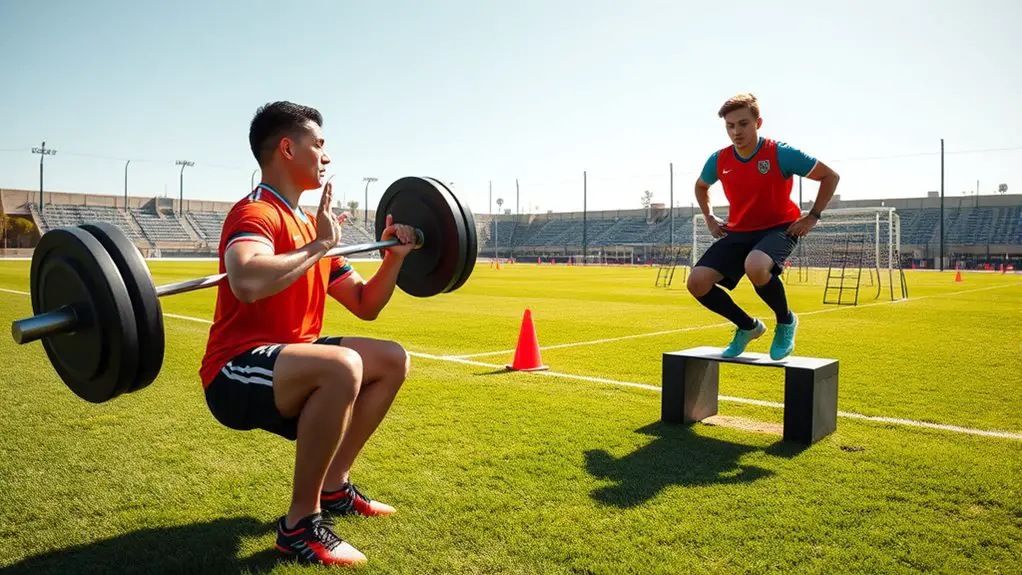To build your grip strength for rowing, focus on exercises like the Farmer's Walk, Plate Pinches, and Wrist Curls. These help enhance your control and power on the water. Incorporating Dead Hangs, Towel Pull-Ups, and Finger Curls will further boost your endurance. Don't forget about Resistance Band Exercises for targeted strength. You can even try Rock Climbing to add variety. Each of these moves contributes to better performance, so stick around for more insights on how to maximize your training!
Why Grip Strength Matters in Rowing
While you might focus on technique and endurance in rowing, grip strength plays an essential role in your overall performance. The importance of grip can't be overstated; it's the foundation that connects your body to the oar. A strong grip allows you to maintain control, ensuring each stroke is powerful and fluid. When you're out on the water, feeling that freedom, your grip becomes the bridge to harnessing every ounce of energy.
Enhancing performance isn't just about your legs and core; your hands need to be equally strong. A firm grip minimizes slippage, allowing for better energy transfer and reducing fatigue. It can even help prevent injuries, giving you the freedom to push your boundaries without worry. Additionally, developing grip strength improves overall health and can elevate your performance in various physical activities. So, while you're perfecting your rowing technique, don't overlook the crucial role grip strength plays. Invest time in building it, and you'll notice improvements that elevate your entire rowing experience.
Farmer's Walk
One of the most effective exercises for building grip strength is the Farmer's Walk. This simple yet powerful movement helps enhance your grip, which is essential for rowing. To perform the Farmer's Walk, grab a pair of heavy dumbbells or kettlebells, stand tall, and walk forward while keeping your shoulders back and core engaged.
The farmer's walk benefits extend beyond grip strength; it also boosts your overall stability and functional strength, making you a more efficient rower. As you walk, focus on maintaining a steady pace and proper posture. Avoid leaning or hunching, as this can lead to injury and diminish the exercise's effectiveness. Incorporating the Farmer's Walk into your routine can empower you, giving you the freedom to handle more challenging rowing sessions with ease. Additionally, this exercise enhances performance in various sports, making it invaluable for athletes. So, grab those weights and step into a stronger, more confident you!
Plate Pinches
One effective way to boost your grip strength is through plate pinches. By focusing on your technique and form, you can maximize the benefits this exercise offers, especially for rowers. Plus, there are several variations you can try to keep your training fresh and challenging. Incorporating exercises like plate pinches is essential for developing grip strength that translates directly to improved performance in rowing.
Technique and Form
To effectively perform plate pinches, it's vital to focus on your grip technique and form. Start by selecting two weight plates; keep them smooth and flat. Your grip positioning is important—place your fingers around the edges of the plates, ensuring you're not squeezing too tightly. Keep your hand alignment straight, with your thumbs wrapping around the plates for extra stability. As you lift, engage your core and stand tall to maintain balance. Remember, control is key; avoid swinging your arms. Focus on holding the plates for as long as possible, challenging your grip strength without compromising your form. By honing your technique, you'll build a solid foundation for improved grip strength, important for rowers seeking freedom in their performance.
Variations for Progression
After mastering the technique and form of plate pinches, it's time to explore variations that can enhance your grip strength further. You can mix things up by trying different weights or increasing the duration you hold the plates. Start with lighter plates and gradually progress to heavier ones as you build strength—this is your journey of progressive overload. You might also consider incorporating grip variations like using a towel around the plates or alternating between pinching with two fingers and all fingers. These tweaks not only challenge your grip but also keep your training fresh and exciting. Embrace these variations and watch your grip strength flourish, giving you the freedom to excel in your rowing pursuits.
Benefits for Rowers
While you might not immediately associate grip strength with rowing performance, the benefits of plate pinches extend far beyond just your hands. By enhancing your muscle endurance, you'll find that your overall rowing experience improves, allowing you to pull harder and longer without fatigue. Moreover, a strong grip plays an essential role in injury prevention, protecting your wrists and elbows from strain during intense workouts.
| Benefits | Impact on Rowers |
|---|---|
| Enhanced Muscle Endurance | Row longer without fatigue |
| Improved Grip Strength | Better control of oars |
| Injury Prevention | Reduced strain on joints |
| Increased Confidence | Freedom to push your limits |
Embrace the freedom that plate pinches provide, and elevate your rowing game!
Wrist Curls
Wrist curls are one of the most effective exercises for building grip strength, essential for rowers who rely on their hands and forearms during intense training. By focusing on wrist stability and forearm strength, you can enhance your performance on the water and reduce the risk of injury. Incorporating joint health into your training regimen is crucial for maintaining overall athletic performance.
To perform wrist curls, sit on a bench with your forearms resting on your thighs, palms facing up. Hold a dumbbell in each hand and curl your wrists upwards, then lower them back down. Aim for three sets of 10-15 reps, adjusting the weight as needed for a challenge without compromising form.
As you build wrist stability through this exercise, you'll notice improved control and power in your rowing strokes. Consistency is key, so incorporate wrist curls into your routine to unleash your full potential and enjoy the freedom of moving effortlessly on the water.
Dead Hangs
Dead hangs are a fantastic way to build grip strength and improve overall upper body endurance, which is essential for rowers. When you hang from a pull-up bar, you engage your forearms, hands, and shoulders, fostering the grip endurance necessary for those long sessions on the water. You can mix it up with dead hang variations, like alternating grips or adding weights, to challenge yourself further.
Start by hanging for 20-30 seconds, focusing on keeping your shoulders engaged and core tight. Gradually increase your hang time as your strength improves. You might also try a one-arm dead hang for an extra challenge, testing your balance and grip endurance.
Incorporating dead hangs into your routine not only strengthens your grip but also enhances your overall performance in rowing, giving you that freedom to row harder and longer without the worry of fatigue.
Towel Pull-Ups
Towel pull-ups are an excellent exercise for enhancing grip strength and upper body power, making them a perfect addition to any rower's training routine. By incorporating towel variations into your workouts, you can introduce unique grip challenges that push your limits. To perform a towel pull-up, simply drape a towel over a pull-up bar and grip the ends tightly.
As you pull yourself up, you'll engage your forearms, biceps, and back while your grip strength takes center stage. Start with a few reps, and feel free to mix in different towel grips to keep things interesting. You can try using thicker towels for an added challenge or even wrap them in various ways to target different muscle groups.
These variations not only build grip strength but also enhance your overall pulling power, which is essential for powerful rowing strokes. Additionally, resistance bands can be incorporated into your routine to further develop grip strength and stability. Embrace the challenge and feel your strength grow!
Finger Curls
After mastering towel pull-ups, finger curls can further enhance your grip strength and forearm development. This exercise targets your fingers specifically, making it vital for building finger strength and improving your grip endurance. To perform finger curls, grab a light dumbbell or a barbell, and allow the weight to roll down to your fingertips. Then, curl the weight back up using just your fingers and control the motion as you lower it again.
Aim for 3 sets of 10-15 reps, focusing on form rather than weight. It's important to feel the burn in your fingers and forearms, as that's where the magic happens. Incorporating finger curls into your routine not only boosts your grip but also enhances your overall performance in rowing. A strong grip means you can hold onto that oar with confidence, allowing you to row freely and powerfully. Additionally, developing core strength through exercises like finger curls contributes to improved stability and control, which are essential for effective rowing.
Resistance Band Exercises
Resistance band exercises are a fantastic way to enhance your grip strength for rowing. You'll benefit from movements like band finger extensions and resisted wrist flexion, which target different muscle groups in your hands and forearms. These exercises can easily be incorporated into your training routine for better performance on the water.
Band Finger Extensions
One effective way to enhance your grip strength for rowing is through band finger extensions. This exercise utilizes band resistance to target your finger strength, promoting better control and stability on the oars. By incorporating this simple yet effective movement into your routine, you'll find that your grip becomes more powerful and resilient.
| Exercise | Reps |
|---|---|
| Finger Extension 1 | 10-15 |
| Finger Extension 2 | 10-15 |
| Finger Extension 3 | 10-15 |
| Finger Extension 4 | 10-15 |
| Finger Extension 5 | 10-15 |
Grab a resistance band, and start building that freedom in your grip! With consistent practice, you'll enjoy the benefits of improved performance while rowing, truly feeling the difference.
Resisted Wrist Flexion
Strengthen your wrists with resisted wrist flexion using a resistance band, an essential exercise for rowers aiming to boost grip and forearm strength. To perform this exercise, anchor one end of the band and grasp the other with your palm facing upward. Slowly flex your wrist, pulling against the band's resistance. This movement not only enhances grip endurance but also helps build wrist stability, vital for maintaining control during strokes. Aim for 3 sets of 10-15 repetitions, ensuring you focus on smooth, controlled motions. Remember, the more resilient your wrists are, the more freedom you'll feel on the water. Integrating resisted wrist flexion into your routine can elevate your performance and overall rowing experience.
Rock Climbing and Grip Training
While many athletes focus on lower body strength, rock climbing offers a unique opportunity to enhance your grip through dynamic movements and varied holds. This exhilarating sport challenges you to engage your entire body, particularly your hands and forearms. By practicing different rock climbing techniques, you'll develop not just grip strength but also finger dexterity and endurance.
Incorporating grip strength tools, like hang boards or fingerboards, can further elevate your training. These tools help isolate specific muscles, allowing you to build strength effectively. As you scale walls and tackle diverse routes, you'll feel your grip improve, which translates well into rowing, giving you that added edge. Additionally, improving your grip strength can enhance your core stability, which is essential for maintaining proper form while rowing.
Embrace the freedom of climbing—every ascent pushes your limits, and each hold strengthens your resolve. So, why not step into a climbing gym and discover the thrill of gripping your way to newfound strength?
Frequently Asked Questions
How Often Should I Train Grip Strength for Rowing?
You might think grip strength training's as essential as breathing! To maximize your rowing potential, aim for a training frequency of two to three times a week. Incorporate grip exercises into your daily routine, but don't overdo it—your muscles need time to recover. Balance your training with other aspects of rowing for that ultimate freedom on the water. Consistency is key, so find a rhythm that works for you and stick with it!
Can Grip Strength Exercises Prevent Injuries?
Yes, grip strength exercises can definitely aid in injury prevention. When you build grip endurance, you're not just improving your ability to hold onto things; you're also reinforcing the muscles and tendons in your hands and forearms. This stability helps prevent overuse injuries, which are common in activities requiring repetitive gripping. So, if you want to enjoy your activities without the nagging worry of injuries, focusing on grip strength is a smart move.
What Equipment Do I Need for Grip Training at Home?
If you're looking to boost your grip strength at home, you don't need a lot of fancy equipment. Simple grip tools like hand grippers, resistance bands, or even a towel can do wonders. You can also use a dumbbell or kettlebell for home workouts. Just get creative! Incorporating these tools into your routine will help you build strength and give you the freedom to train whenever it suits you best.
Are There Age Restrictions for Grip Strength Exercises?
You might wonder if there are age restrictions for grip strength exercises. The truth is, age considerations can play a role, especially when it comes to youth training. While young athletes can certainly benefit from grip exercises, it's essential to guarantee they're age-appropriate and safe. There's no strict age limit, but proper guidance and supervision can help avoid injuries and foster healthy development. So, keep it fun and engaging, and watch the strength grow!
How Long Until I See Improvements in Grip Strength?
You'll likely start seeing improvements in grip strength within a few weeks of consistent training. It's important to track your progress to stay motivated. Set strength standards for yourself and adjust your routine as you advance. Remember, everyone's journey is different, so don't rush it. Enjoy the freedom that comes from building your strength. With patience and dedication, you'll reach your goals and feel empowered along the way.




